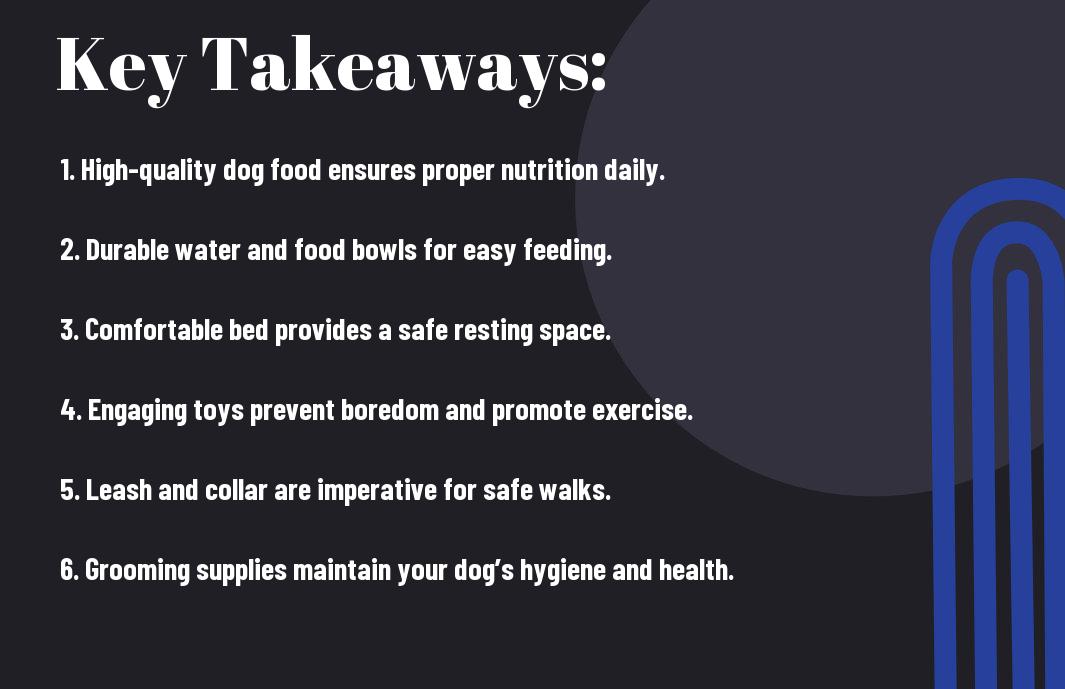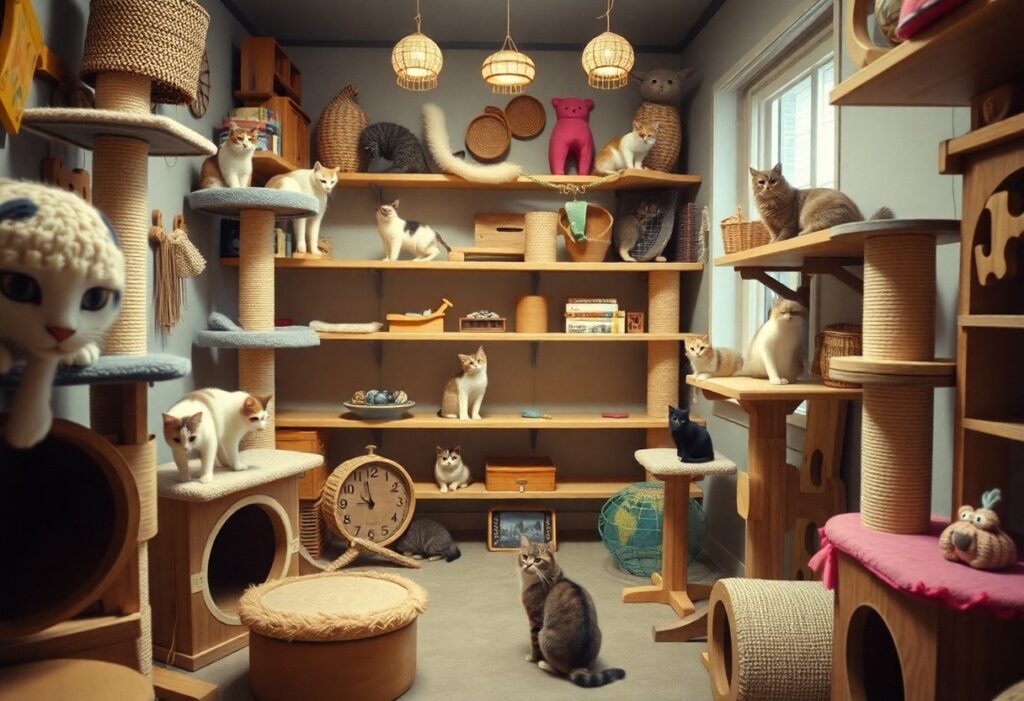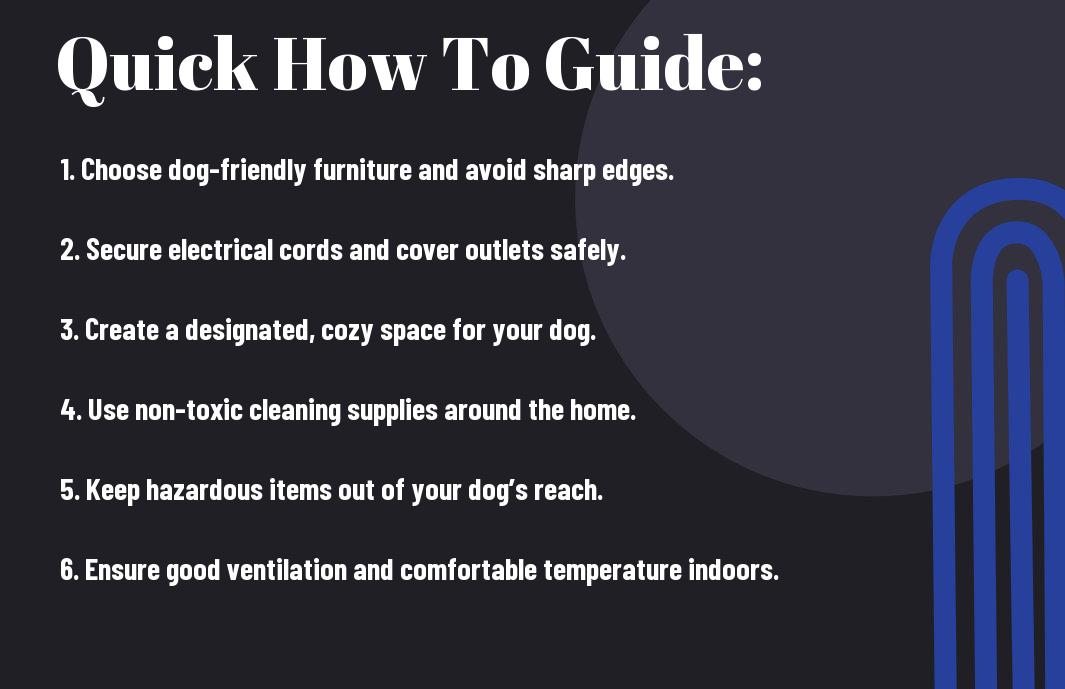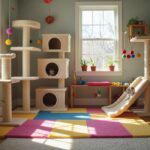You want the best for your furry friend, and that starts with creating a safe and comfortable home environment. By taking simple yet effective steps, you can protect your dog from potential hazards around the house, such as toxic plants and sharp objects. Ensuring that your home is both secure and inviting will not only enhance your dog’s well-being but also strengthen the bond you share. This guide will provide you with practical tips to transform your space into a haven for your beloved pet.

Understanding Your Dog’s Needs
The bond you share with your dog is a beautiful part of your life together, and understanding their needs is important for their well-being. When you create a living space that caters to these needs, you set the stage for a happy and healthy dog. Your furry friend thrives on understanding their environment, which allows them to feel safe and secure.
Physical Space
Understanding your dog’s need for physical space entails creating a comfortable living environment that accommodates their size, breed, and activity level. Ensure that there is enough room for them to move around freely while also providing designated areas for rest, play, and exploration. For example, a cozy bed in a quiet corner offers a safe retreat, while a designated play area allows them to engage in physical activities, keeping them active and happy.
Additionally, eliminating potential hazards in your home is vital to maintain a safe environment. Keeping sharp objects, toxic plants, and chemicals out of reach helps prevent injuries, allowing your dog to explore their surroundings with confidence. You can enhance their physical space with items that stimulate their senses, such as toys that promote mental engagement and wellness.
Emotional Well-being
Space plays a significant role in your dog’s emotional health. A calm, organized environment reduces anxiety and promotes relaxation, allowing your dog to unwind and feel secure. Dogs can easily sense changes in their surroundings, so maintaining a stable and predictable home environment contributes to their feelings of safety. Incorporating comfortable and familiar items, such as blankets or toys, can also help comfort them during stressful situations.
Also, providing a routine in their daily activities can greatly enhance your dog’s emotional stability. Regular feeding times, walks, and play sessions create structure which helps your dog feel more secure. This predictable environment encourages their natural instincts and makes them feel more at home.
Social Interaction
Across the dog community, social interaction is important for both physical and mental health. Engaging with other dogs and people can help your dog develop important social skills, ensuring they remain well-adjusted and friendly. Regularly scheduling playdates or trips to the dog park will provide them opportunities to interact, and also help to reduce feelings of loneliness and boredom.
Dogs are naturally social creatures who derive joy from spending time with their family, both human and canine. Ensuring that your dog has sufficient social engagement fosters a sense of belonging and encourages them to develop positive relationships. This critical interaction not only enriches their lives but also gives you more opportunities for bonding experiences.

Safe Home Environment
Even in the most loving homes, hazards can lurk in places you might not immediately recognize. When creating a safe home environment for your dog, it is necessary to conduct a thorough sweep of your living space. This involves assessing your home for potential dangers that could harm your furry friend, including toxic plants, small objects that can be swallowed, and exposed electrical cords. By being proactive and identifying hazards, you can significantly reduce the risk of accidents and injuries.
Hazard Identification
About 80% of household items can pose a risk to your dog, from cleaning supplies and medications to common food items that are toxic to pets. It’s vital that you keep these items well out of reach, preferably in secure cabinets that your dog cannot access. Additionally, pay special attention to the yard or garden area, which should be free of harmful chemicals and plants like certain types of lilies or azaleas that are known to be toxic to dogs.
Furthermore, evaluating furniture and decor is equally important. Make sure to eliminate or secure things like sharp corners, heavy objects that could fall, and small decorations that could become choking hazards. A detailed hazard assessment helps create a comforting space for your dog where they can feel at ease, minimizing their stress and promoting a sense of safety in their environment.
Safe Spaces for Dogs
Along with identifying hazards, it’s equally important to provide your dog with designated safe spaces within your home. Dogs thrive in environments where they can retreat to when feeling overwhelmed or tired. Establishing a cozy corner filled with their favorite blankets, toys, and a comfortable bed gives them a sense of ownership and that they have a space to call their own. This type of setup not only promotes relaxation but also fosters a deep bond between you and your dog.
Household areas such as a specific room or a quiet nook away from the noise can act as a sanctuary for your dog. You might consider using baby gates to create a dog-friendly zone, ensuring that they have access to their safe space while still being part of family activities. It’s a positive practice to include cozy items, like their bedding or a piece of your clothing, to provide a sense of familiarity and comfort. Ultimately, establishing these safe zones contributes to your dog’s well-being and happiness, allowing them to flourish in a loving home environment.
Comfortable Living Conditions
To create a warm and loving home for your dog, you must prioritize their comfort and well-being. This involves ensuring that your living conditions meet their needs, particularly in terms of temperature control and providing appropriate bedding and rest areas. By paying attention to these important aspects, you can help your furry friend feel safe and secure in their environment.
Temperature Control
Control your dog’s comfort by managing the temperature within your home. Different breeds have varying tolerances to heat and cold, and it’s vital to provide a suitable atmosphere to prevent stress or health issues. Below is a summary of temperature recommendations and tips to keep your dog comfortable:
| Temperature Tips | Description |
|---|---|
| Summer | Keep your home cool, ideally between 68°F to 75°F. Provide shade and plenty of water for your dog. |
| Winter | Maintain a warm environment, ideally between 70°F to 78°F. Ensure your dog has a cozy space to retreat to when it’s chilly outside. |
Creating breezy areas in summer and snug spots in winter can significantly enhance your dog’s comfort. Install fans or turn on the air conditioning when it’s too hot, and provide heated blankets or dog-specific sweaters when temperatures drop.
Proper Bedding and Rest Areas
One of the most effective ways to ensure your dog feels safe and comfortable is by providing proper bedding and designated rest areas. Choosing the right bed is vital, as it should meet your dog’s specific size and sleeping preferences. Additionally, consider the location of the bed within your home for optimal comfort.
Comfort is achieved when you choose a bed that supports your dog’s joints and allows them to stretch out fully. Look for options with high-quality materials that offer both support and temperature regulation. It’s also important to create a quiet, soothing environment where your dog can unwind and feel secure. This area should be free from disturbances and provide a cozy retreat for your beloved pet.

Nutrition and Diet
Many dog owners may not fully understand the importance of nutrition and diet in creating a safe and comfortable home environment for their furry companions. Providing a balanced diet not only keeps your dog healthy but also helps prevent potential health issues that could arise from poor dietary choices. Ensuring your dog has access to safe food options is a fundamental aspect of their well-being that you should prioritize.
Choosing Safe Foods
After bringing your dog home, one of the first steps you should take is carefully selecting the right food for them. Opt for high-quality dog food that meets the nutritional requirements specific to your dog’s age, breed, and health condition. Look for brands that provide complete and balanced nutrition. Avoid foods containing fillers, artificial additives, or substances that can be toxic to your dog, such as chocolate, grapes, and onions. Always read the ingredient labels, as transparency in the food you choose is vital for your dog’s long-term health.
Additionally, it may be beneficial to consult with your veterinarian to determine the best diet for your dog. They can provide recommendations tailored to your dog’s unique needs, including any special dietary requirements they may have. This professional insight can be instrumental in avoiding potential health risks associated with improper feeding choices.
Establishing Feeding Areas
Feeding your dog in a designated area of your home is imperative in creating a safe and organized environment. Choose a quiet space that is free from distractions, where your pet can eat peacefully. This can also prevent any food aggression issues that may arise if your dog feels threatened during mealtime. A special mat or bowl may also help in reducing mess, making it easier for you to clean up.
Establishing a routine for feeding times can significantly enhance your dog’s comfort and predictability in the home. By offering meals at the same time each day, you are providing structure, which is particularly beneficial for dogs that thrive on consistency. Ensure that your dog’s bowls remain at a safe distance from high-traffic areas to avoid spills or accidents, creating a more secure feeding environment.
Hydration and Water Availability
Along with a proper diet, ensuring your dog has constant access to clean and fresh water is vital for their health. Hydration plays an imperative role in regulating various bodily functions, and having adequate water available prevents issues such as dehydration, which can lead to serious health concerns. Make it a routine to check your dog’s water bowl daily, replacing old water with fresh supplies and cleaning the bowl regularly to prevent any bacterial growth.
Hydration needs can vary based on factors such as activity level, breed, and environmental conditions. Keep an eye on your dog’s water consumption, and if you notice they’re drinking significantly less than usual, consult your veterinarian for guidance. Providing a variety of water sources, such as water fountains or bowls placed in different areas, can also encourage your dog to drink more and stay hydrated.
Mental Stimulation and Exercise
Keep in mind that your dog’s well-being goes beyond just providing food and shelter; exercise plays a significant role in their overall health. Regular physical activity helps maintain a healthy weight, promotes cardiovascular health, and reduces the risk of various health problems. Additionally, keeping your dog active can alleviate behavioral issues such as chewing, barking, or digging, which often stem from pent-up energy. Ensuring your furry friend gets enough exercise will lead to a happier and more balanced life.
Importance of Exercise
Beside physical health benefits, exercise is paramount for your dog’s mental well-being. Engaging in daily walks or playtime not only keeps their body fit, but it also provides opportunities for socialization and interaction with their surroundings. Exploring new environments and encountering other dogs or people can stimulate their senses and enhance cognitive development. A well-exercised dog is likely to exhibit better behavior, making your home a more harmonious space.
Enrichment Activities
Activities that challenge your dog’s mind are just as important as physical activity. Incorporating enrichment activities into your dog’s routine can keep them mentally sharp and engaged. These can include puzzle toys, hide-and-seek games, or even teaching new tricks. By stimulating their brain, you can help prevent boredom and quell any destructive behaviors that may arise from a lack of mental challenges.
At home, you can set up different enrichment activities that cater to your dog’s interests and abilities. For example, puzzle feeders encourage problem-solving skills, while interactive games such as scent work can engage your dog’s natural instincts. Ensure that you regularly rotate these activities to keep them fresh and exciting for your furry friend. By providing a variety of mental challenges, you can help enrich your dog’s life, promoting a deeper bond while keeping them happy and satisfied in their environment.
Socialization and Interaction
For your dog to thrive emotionally and psychologically, proper socialization and interaction are necessary. The experiences your dog has during their formative months can shape their behavior for life. Socialization helps your dog learn how to interact appropriately with other dogs, animals, and people, reducing the chances of fear-based reactions or aggression later on. When done correctly, socialization fosters confidence, allowing your dog to enjoy a wider range of experiences without anxiety.
Importance of Socialization
Between the ages of 3 and 14 weeks, puppies are in a developmental window where they are particularly receptive to new experiences. This is the ideal time to expose them to various environments, sounds, and other animals. By introducing your dog to diverse situations, you equip them with the tools they need to navigate the world with ease. As a result, your dog is likely to become a well-adjusted member of your family, capable of exhibiting calm behavior in various scenarios.
Additionally, socialized dogs tend to have a better quality of life. They are less likely to develop separation anxiety, which can lead to destructive behavior while you are away. Ensuring consistent socialization periods within their routine solidifies their learning and reinforces good behaviors. This way, you create an environment where your dog feels secure and happy.
Arranging Playdates
On your journey to socializing your dog, arranging playdates is one of the most effective methods. Visiting friends or family members who have dogs can give your pet a chance to interact with their peers in a fun and lower-stress setting. During these playdates, your dog can develop vital communication skills, learning how to read body language and distinguishing between playful and aggressive behavior. This hands-on experience is invaluable in fostering emotional intelligence and confidence in your dog.
But it’s necessary to ensure that the dog you are introducing your pet to shares a compatible temperament. A wrong match can lead to stress or fear, which is counterproductive to the goal of socialization. Pay attention to your dog’s cues and be ready to step in if play becomes too rough. Always supervise the interactions to maintain a safe environment for both dogs involved.
Visiting Dog Parks
One great option for socialization is visiting dog parks. These settings typically offer a structured space for dogs to interact and engage in play, providing ample opportunities for social learning. Dog parks can expose your dog to different breeds, sizes, and personalities, allowing them to acclimate to diverse situations. Just be sure to observe your dog closely and ensure they are interacting positively with others, as not every encounter will be friendly.
Plus, dog parks can be a splendid way for you to connect with fellow dog owners, exchanging tips and experiences while your pets play. A safe park environment promotes a feel-good atmosphere, and your confidence in managing such interactions will contribute to your dog’s comfort and enjoyment as well. Always check for park rules and ensure vaccinations are up to date to ensure a healthy and enjoyable experience for both you and your dog.
Conclusion
Summing up, creating a safe and comfortable home environment for your dog involves various thoughtful considerations that can greatly enhance their well-being. Start by assessing your home for potential dangers, such as toxic plants or small objects that could be swallowed. Ensure that your dog’s living area is cozy and inviting, incorporating their favorite blankets, toys, and a comfortable bed. You can further enrich their environment by providing stimulation through interactive toys and regular exercise, fostering both their physical and mental health.
Additionally, establishing routines can bring a sense of stability and comfort to your dog’s life. By ensuring that your dog feels secure and loved within your home, you are setting the foundation for a strong bond between you and your pet. A well-structured environment can lead to a happier, healthier dog, ultimately making your shared home a warm and inviting space for both of you. Prioritizing their needs will not only benefit your dog but will also enhance your overall experience as a pet owner.
Q: How can I ensure my home is safe for my dog?
A: To create a safe environment for your dog, start by removing any hazardous items such as cleaning supplies, medications, or small objects that could be swallowed. Install baby gates to restrict access to stairs or certain rooms. Ensure that windows and balconies are secure to prevent accidental falls. Additionally, check your garden for toxic plants, chemicals, or sharp objects that might harm your pet. Regularly inspect your home for any potential dangers as your dog grows and explores their surroundings.
Q: What are some ways to make my home more comfortable for my dog?
A: To enhance comfort for your dog, provide a dedicated space where they can relax, such as a cozy bed or a soft rug. Make sure their sleeping area is in a quiet corner of the house, away from noise and activity. Offering plenty of toys and interactive games can help keep them engaged and prevent boredom. Additionally, consider the temperature; ensure that your home is neither too hot nor too cold for your dog, and provide fresh water at all times to keep them hydrated.
Q: How can I create a dog-friendly space while maintaining my home’s aesthetics?
A: Striking a balance between a dog-friendly environment and maintaining the aesthetic of your home can be achieved by choosing stylish yet functional furniture and decor. Consider using durable, easy-to-clean materials for furniture and rugs that can withstand wear and tear. Use beautiful storage solutions for dog toys and accessories to keep the space organized. Incorporate pet-friendly design elements, such as decorative pet beds or wall-mounted feeding stations, that blend seamlessly with your existing decor while catering to your dog’s needs.










